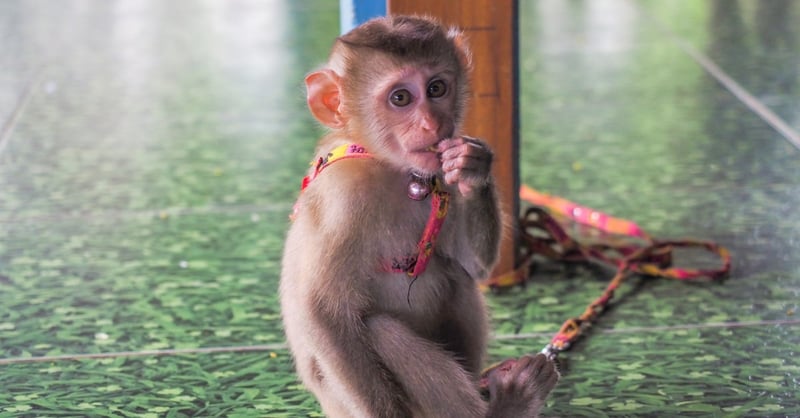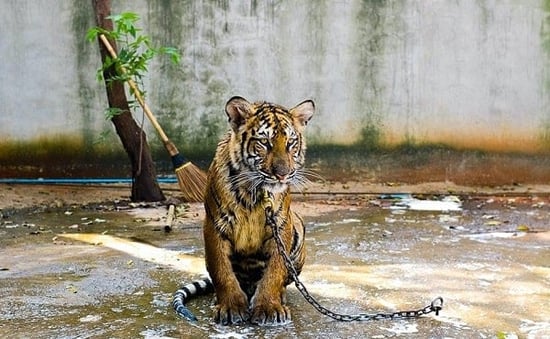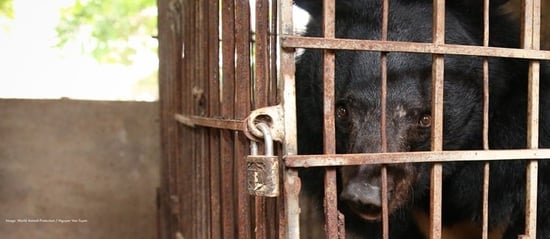
Monkey abuse videos on the rise as social media policies fail to protect animals
News
You helped us collaborate with various animal protection organisations of the Asia for Animals Coalition network to launch a new report that documents evidence of social media fuelling cruel monkey abuse videos on popular platforms like Facebook, YouTube and TikTok.
The latest report “The cruelty you don't see: The suffering of pet macaques for social media content” by the Asia for Animals’ Social Media Animal Cruelty Coalition (SMACC) documents evidence of content creators inflicting intentional abuse on monkeys in videos shared on social media platforms to generate likes and views from other users.
In these videos, content creators are seen forcing their pet monkeys to perform or to cope with stressful and distressing situations, resulting in the physical and psychological abuse of the animals in the name of social media content.
The report also found several fake macaque rescue videos which involved deliberately putting the animal’s life at risk and then “rescuing” them from these manufactured situations.
It also highlighted a lack of strong policies to protect animals from being abused for social media content while also pointing out that the existing ones largely fail to consider the long-term animal welfare issues such as physiological damage from living in captivity.
Dr Neil D’Cruze, Global Head of Wildlife Research, World Animal Protection said:
Some of the content shared on social media is incredibly hard to watch. Let’s be clear, this is not entertainment for ‘likes’ and ‘shares,’ this is animal abuse. Many of these videos depict extremely violent content showing the intentional abuse torture and killing of macaques.
Social media platforms are normalizing the cruel treatment of macaques by allowing these videos to remain on their platforms. They have a responsibility to shut-down these content creators and send a message that animal cruelty is not to be tolerated. These platforms need to proactively step up and take action to stop animal cruelty content being uploaded in the first place.
If you see this type of content – report it, do not engage with it. We all have a role to play.
Cruelty behind the camera
A majority of the monkey abuse videos involved infant macaques wearing dresses, shirts or even diapers to look like “human children.” These animals were likely ripped from their parents in the wild just days after being born and sold into the barbaric global wildlife trade to be pets.
As a result, they often suffer psychological and emotional damage and display behaviours that are often misinterpreted by social media users as positive. Such behaviours include smiling or grinning which indicate high stress, fear, and aggression.
When these pet monkeys reach maturity, they can become difficult to handle and may be abandoned by their owners.
SMACC’s research into this inherently abusive social media trend between September 2021 and March 2023 found a staggering 1226 pieces of content that revealed the following:
- 13% of the content featured deliberate psychological torture: macaques were intentionally made to feel fear and distress in response to scaring, teasing and being denied food
- 12% showed macaques being physically tortured, including being beaten, burnt alive, limbs amputated and many of them tortured until death
- Shockingly, 60% of the links showed pet macaques being directly physically abused
- All macaques featured were likely to experience psychological distress due to their treatment
- Collectively, the links had been viewed 12,054,378,907 times at the time of analysis
- Top three platforms with the most content featuring macaques as pets were Facebook (60%), YouTube (24%), and TikTok (13%)
You have the power to end to macaque suffering
As a social media user, you can play a vital role in ending monkey suffering. You can help end the exploitation of monkeys by following three simple rules:
- Be mindful: using any wild animal for entertainment is cruelty (this includes pets)
- Report the content that includes a wild animal – if there is no option for "animal cruelty", then select the closest category. You can also report cruel content to the SMACC reporting form.
- Don’t watch, like, comment or share such videos because any engagement is considered positive by the algorithm and could encourage content creators to make more such videos.
Together, we can make the world a compassionate place for animals both online and offline.
Images credit: Asia for Animals Coalition
Macaques are highly intelligent and social creatures. They form relationships and can remember past interactions; they groom each other as a sign of affection and respect. They think and feel and show emotions. Some of these animals will be living in abject fear and terror.
Animals, not entertainers
Across the globe, animals at wildlife tourism venues are forced to endure intense pain and mostly unseen suffering to entertain tourists and visitors on a daily basis.
Will you protect animals?
Every animal deserves a life worth living – from captive lions used for trophy hunting to mother pigs in cages in factory farms.



